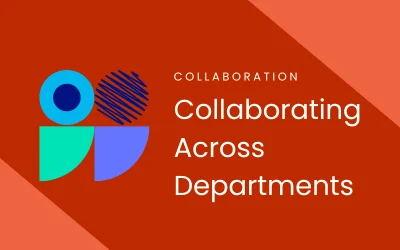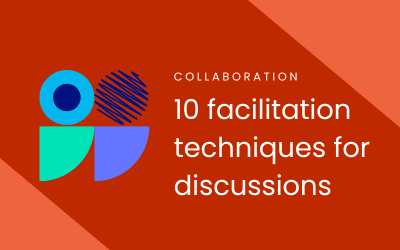Great design is rarely the result of a single, genius mind. Great design is a result of a team effort — and knowing how to collaborate effectively is an important skill for every designer. While we often strive for best practices and guidelines — and there are a lot of principles and design patterns to learn from — we also live in a world of constant change. To come up with good solutions, we must bring diverse perspectives together.
Collaboration enables teams to adapt faster to changing requirements, iterate on design ideas, and ultimately deliver products that resonate with users and drive business success.
This article outlines key methods that UX teams can use to foster collaboration when designing new products.
Workshops

What it is
A workshop is a way to bring people together for an interactive working session. It allows people to discuss and exchange ideas.
When to use
A workshop is a good method if you want to:
- collect ideas
- create team alignment
What to consider
A workshop is being organized and run by a facilitator. Setting up a workshop requires planning time to clarify the outcomes, identify participants and define workshop activities. A workshop can range from 1.5 hours to multiple days.
Examples
In product design, you can use a workshop for every step. Here are some workshop categories as an inspiration:
- knowledge collection/ assumptions/ gap analysis
- brainstorming/ ideation/ design thinking
- decision making/ voting
- feedback
Surveys

What it is
A survey is a list of questions that is used to collect data from a group of people. It can be either sent out to people to self-respond, or it can be used in a guided interview format.
When to use
A survey can be a good approach if you need to collect input from a larger group on a very well-defined topic. Open-ended questions will help you collect new ideas and insights, which is helpful in the discovery phase. Closed questions (like ratings, multiple-choice, or single preferences) are best used for validation.
What to consider
Consider how you want to use the results before brainstorming questions. When you send out a survey, include a deadline for filling it out. Send reminders to increase participation.
Examples
Surveys in the discovery phase can be helpful to collect:
- current behaviour and needs (needs analysis)
- preferred tools and methods (competitor check)
- testing assumptions
Surveys in the validation phase can be used for:
- feedback and preference (A/B testing)
- satisfaction
Lunch & Learn

What it is
A lunch and learn is an organized event in a professional work environment where teammates come together for professional development while enjoying a meal or their lunch break. It’s an informal event and an excellent way to unite people from different departments. The format is usually a presentation or storytelling followed by an open discussion.
When to use
Lunch and learn is a great opportunity to share knowledge and start discussions. You can start sharing lessons learned: processes or methods that you and your team have tried, what worked and what didn’t. You can collect feedback on how to work better together as a team or improve your workflows to benefit other departments.
Use lunch and learns as a temperature gauge and idea collection for the bigger, organized working sessions you might want to do. They are also a networking opportunity and can help promote your and your team’s work.
What to consider
Lunch and learns are voluntary so that you won’t have a fixed list of attendees. You should keep them short and leave enough time for discussion and input.
Examples
You can share lessons learned from user research:
- Common customer profiles and their needs or pain points (make it relatable for other departments)
- Customer stories (success and frustrations)
- Research process and how to involve research across the organization
Project War Rooms

What it is
A project war room is a place where a project team can gather their ideas, plans and work in progress.
When to use
A war room is helpful for big projects that require a fixed team of people from different departments to work together for a longer time. It provides space to not only come together and discuss ideas but to collect and share physical outputs. Being able to see outputs, like sketches, notes, and prototypes, will support a creative workflow.
A war room is not only a great working hub for the project team but can also be an invitation to people outside of the project team: they get a glimpse of how the design process works.
You can also invite users into your workspace to get feedback.
What to consider
You need a dedicated space that you can keep for the required length of time. The space should allow you to use walls to put up ideas and notes.
Examples
Working on new features or product improvements that require people with different skill sets: bring them together for a couple of weeks to work on solutions collaboratively.
Gallery Walk

What it is
A gallery walk is a discussion and feedback technique that allows people to learn from each other. Teams and departments can share their current work (in a poster format with descriptions and images, in a short video or in a prototype) in an open space. People can then walk around, get familiar with the different ideas, ask questions, leave feedback and provide input.
When to use
It’s a great method to reduce barriers between departments and introduce people to work that other teams are doing. It is a networking event that engages people from other areas of the organization. It is also an excellent way to showcase and promote your team’s work.
What to consider
This is an organized event that requires time for planning and preparation, not just for the organizer but also for each participating team. To ensure rich participation, you want to select a time and place that works best for the majority of your organization.
Examples
- Yearly showcases of projects in progress
- Showcase of most successful projects or products
- Celebrating big wins in the organization
Interactive Meetings

What it is
An interactive meeting can be described as a “mini workshop,” often spontaneously. The better your facilitation skills and the bigger your toolbox, the more you can jump in and turn a meeting into an engaging, interactive session.
When to use
If you find yourself in a discussion where a group gets stuck, you can use interactive methods to move the team forward: voting exercises, pros and cons lists, and brainwriting.
What to consider
Interactive meetings can be planned — but don’t have to. It’s more about providing facilitation support when a group gets stuck.
Over to you
This list should inspire you for your next collaborative opportunity. Start experiments to see what works best for your situation: pick a method you have never used before or use a known method in a new context.
Happy co-designing!




